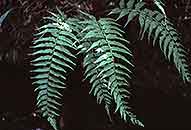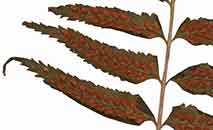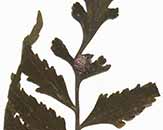Asplenium boltonii Hook. ex Brause & Hieron.
Synonyms |
Asplenium anisophyllum var. elongatum Mett. |
|---|---|
Common name |
|
Description |
Rhizome erect or sometimes shortly creeping, 20 mm thick, fleshy, branching on large plants; rhizome scales brown with pale margins, linear-lanceolate in outline, up to 18 x 2 mm. Fronds uniform, tufted, gemmiferous towards the base of the apical pinna. Stipe up to 26 × 0.4 cm, stipe and rhachis with reddish-brown hairlike scales up to 14 mm long, later becoming subglabrous. Lamina up to 80 × 22 cm, pinnate with 13 to 28 pairs of pinnae, with the lowest pinnae slightly reduced, ovate-lanceolate in outline. Pinnae lanceolate in outline, 4-10(-15) x 1-1.5(-1.8) cm, apex gradually tapering to a point, base asymmetrical, margins irregurly incised into bilobed teeth, hairless above, with scattered hairlike scales below when young, veins forked. Sori oval, 3-8 mm long, set along the veins at 30 degrees to the costa; indusium subelliptic, entire, 1-1.5 mm broad. |
Notes | Confused with A. anisophyllum but A. boltonii is gemmiferous; confused with A. gemmiferum but A. boltonii has less broad pinnae with margins incised 1/3 way to the costa. |
Derivation | boltonii: type specimen was collected by General D. Bolton in Natal. |
Habitat | Dense shade, along streams in evergreen moist forest. |
Distribution worldwide | Africa, Madagascar, Réunion. |
Distribution in Africa |
Burundi, Dem. Republic of Congo, Equatorial Guinea (incl. Bioko), Kenya, Malawi, Mozambique, Rwanda, South Africa, Swaziland, Tanzania , Uganda, Zambia, Zimbabwe. |
Growth form |
Epiphytic, lithophytic, terrestrial. |
Literature |
|



